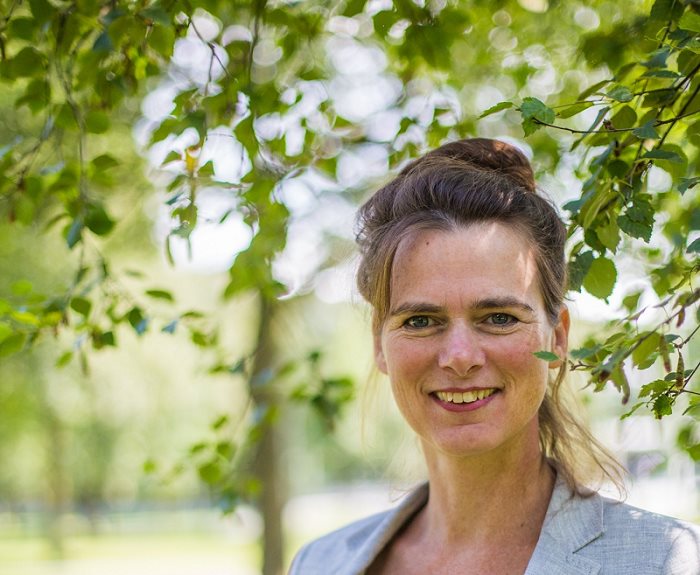Sustainable Pioneer in Healthcare: How Radboudumc Works with Circular Procurement

Every hospital wants the best care for its patients. Radboudumc in Nijmegen has an additional goal: sustainable care, which means having a maximum positive impact on health and minimal negative impact on the environment.
Harriette Laurijsen, a strategic sustainability advisor at Radboudumc, explains why sustainability is important for this university medical center. She also tells us how to solve problems with circular ambitions.

How would you describe Radboudumc’s vision for circular procurement?
Harriette: “About seven percent of Dutch CO2 emissions are caused by healthcare. As a university medical center, you are a healthcare institution, yet we also inadvertently contribute to the climate crisis. Climate change has a negative impact on health, so we want to help reduce this. We have been pursuing an active sustainability policy for ten years.”
“We approach sustainability integrally. In addition to the environmental impact, we also focus on the social aspect: ‘equal opportunities for everyone.’ We aim for a sustainable organization down to the core. Ultimately, all employees and students think and act sustainably.”
Green policy as a common thread then. How did this originate with you?
“In the past, we encouraged sustainability by inviting employees to develop sustainable ideas and initiatives. That worked well, but not for complex processes or at a structural level. Sustainable procurement, for example, depended on the willingness of a purchasing department. We wanted to move beyond that. That’s why we set ambitions for socially responsible procurement at the central level.”
“Since 2022, SRI has become a fixed part of our procurement policy. In all tendering processes, a number of steps are taken in the field of sustainability. In accordance with the joint sustainability policy with Radboud University, we focus on four ambitions: a healthy environment, climate-neutral, circular, and equal opportunities.”
What obstacles do you encounter in circular procurement?
“Sometimes sustainable alternatives are not yet available. About seven years ago, we wanted sustainable service clothing, which no supplier offered. That’s why we launched a project with MVO Nederland to develop a sustainable clothing line together with suppliers. This turned out to be a success.”
“This procurement process inspired other suppliers also to offer a sustainable clothing line. Many hospitals now have sustainable clothing. The procurement staff at the Ministry of Defense are even going one step further in sustainability requirements: their clothing needs to consist of at least 10% reusable materials. Ambitions like that create huge demand which is the domino effect that the market needs.”
“Medical aids are more difficult to produce sustainably, nevertheless you see a step-by-step development in the market, not only with large but also with small suppliers in the medical industry. The challenge here is to make or keep sustainable alternatives affordable, which often requires large production numbers. This means that we, the healthcare sector as a whole, need to start making different choices.”
What is the future of circular procurement in the healthcare sector?
“Circular working is one of the five themes of the Green Deal ‘Working Together on Sustainability.’ Together with other hospitals we focus on reducing waste, sustainable material use, and gaining knowledge. Dialogue with suppliers is essential in this regard.”
What themes offer opportunities?
“Firstly, combating waste. Preventing the provision of unnecessary care and the unnecessary use of products is the most sustainable care there is. There is still much to be achieved in this area.”
“Secondly, purchasing the most sustainable products possible. The medical sector still has a way to go in this regard. Sustainable alternatives are often not available. In that case, we discuss with the supplier about making their offering more sustainable or challenging the market by adding sustainability requirements and wishes to a tender.”
Collaboration is essential in sustainability. Read how the buyer group textiles in healthcare join forces to work on more sustainable materials.
How does the partnership with MVO Nederland help you with sustainability?
“An example is the sterile operating gowns. Almost all hospitals use disposable gowns. Reusable operating gowns are more sustainable, but unfortunately also more expensive. MVO Nederland gives healthcare providers a seat at the table, so together they can scale up and make it possible to lower the price. Healthcare must also remain affordable; this is the balance we need to maintain.”
“MVO Nederland also supports in other areas, for example by transferring knowledge or conducting a baseline measurement. The questions are: What is the most sustainable operating gown and why? Which hospitals use which gowns and how many? Which suppliers have a sustainable offer?”
What do you think is still needed from politics
“Together with other healthcare branches, we submitted a financing request to the government. In addition, laws and regulations sometimes work against us. For example, the Medical Device Regulation (MDR) guideline sets requirements for medical device products. In some cases, this limits us.”
“The Green Deal Sustainable Healthcare sets goals for circularity. For example, we aim for a maximum of 25% unsorted residual waste by 2030. This is challenging, as we are currently at around 65%. This requires current (medical) products to be recyclable or reusable, which is not a nice to have, but a need to have.”
What is your tip for other companies for circular procurement?
“For many healthcare institutions, socially responsible procurement is too complex. Joint procurement offers a solution. This way, you spread risks, enlarge the market, and gain speed. Large parties then take the smaller ones with them. And if you cannot purchase jointly, at least share knowledge.”


